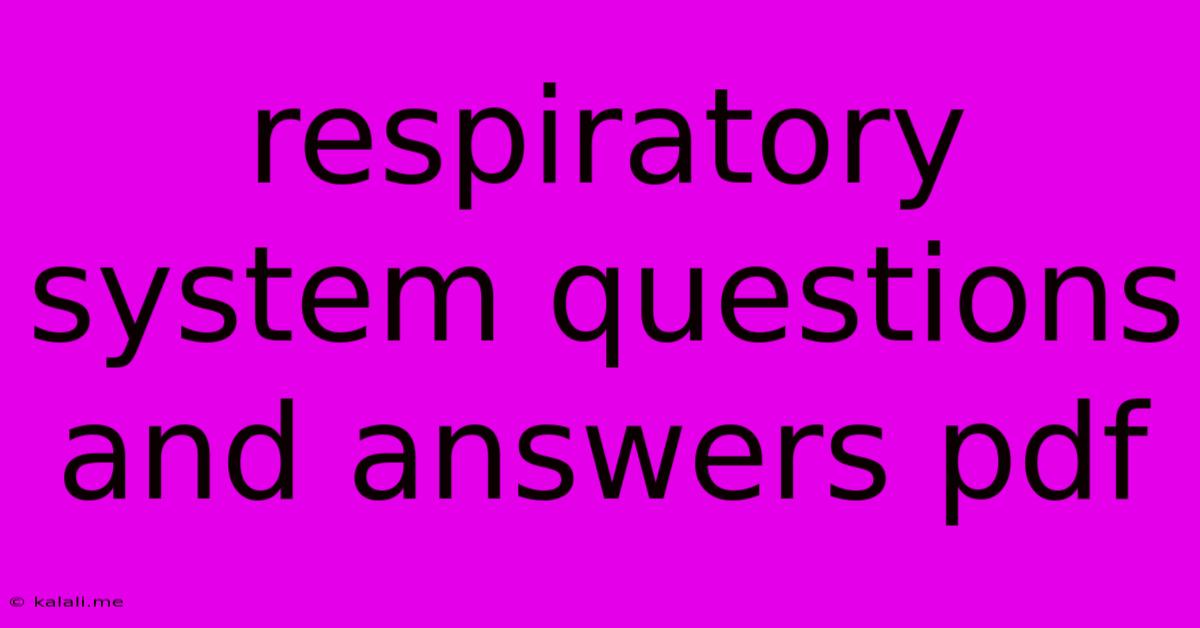Respiratory System Questions And Answers Pdf
Kalali
Jun 15, 2025 · 3 min read

Table of Contents
Respiratory System Questions and Answers: A Comprehensive Guide
This article serves as a comprehensive guide to common questions and answers regarding the respiratory system. Understanding how our lungs work is crucial for maintaining good health. This guide covers everything from basic anatomy to common respiratory illnesses, providing clear explanations suitable for students, healthcare professionals, or anyone interested in learning more about this vital system. Downloadable PDFs are not provided directly, but the information here can easily be compiled into a personalized study guide.
What is the Respiratory System?
The respiratory system is the network of organs and tissues that allows us to breathe. Its primary function is gas exchange: taking in oxygen (O2) and releasing carbon dioxide (CO2). This process is essential for cellular respiration, providing the energy our bodies need to function. Key components include the nose, pharynx, larynx, trachea, bronchi, lungs, and diaphragm. Understanding the interplay between these components is key to understanding respiratory health.
Key Components and Their Functions:
- Nose and Nasal Cavity: Filters, warms, and humidifies incoming air.
- Pharynx (Throat): Passageway for both air and food.
- Larynx (Voice Box): Contains vocal cords; protects the trachea from food aspiration.
- Trachea (Windpipe): Carries air to the lungs.
- Bronchi: Branching airways within the lungs.
- Bronchioles: Smaller branches of the bronchi.
- Alveoli: Tiny air sacs where gas exchange occurs.
- Lungs: The main organs of respiration; contain alveoli.
- Diaphragm: Muscle that helps control breathing.
Common Respiratory System Questions and Answers:
1. How does breathing work?
Breathing, or pulmonary ventilation, involves two main processes: inhalation (inspiration) and exhalation (expiration). Inhalation is the active process where the diaphragm contracts, expanding the chest cavity and drawing air into the lungs. Exhalation is largely passive; the diaphragm relaxes, causing the chest cavity to shrink and air to be expelled from the lungs. This rhythmic process is crucial for maintaining adequate oxygen levels in the blood.
2. What are the common respiratory illnesses?
Several illnesses can affect the respiratory system, including:
- Asthma: A chronic condition causing airway inflammation and narrowing.
- Pneumonia: Infection of the lungs' alveoli.
- Bronchitis: Inflammation of the bronchi.
- Emphysema: A chronic lung disease causing damage to the alveoli.
- Lung Cancer: A serious disease resulting from uncontrolled cell growth in the lungs.
- COVID-19: A viral infection primarily affecting the respiratory system.
3. What are the symptoms of respiratory problems?
Symptoms vary depending on the condition, but common signs include:
- Cough: Can be dry or produce mucus.
- Shortness of breath (dyspnea): Difficulty breathing.
- Wheezing: A whistling sound during breathing.
- Chest pain: Pain in the chest area.
- Fatigue: Extreme tiredness.
- Fever: Elevated body temperature.
4. How can I improve my respiratory health?
Maintaining good respiratory health involves:
- Avoiding smoking and secondhand smoke.
- Practicing regular exercise.
- Eating a healthy diet.
- Getting enough sleep.
- Practicing good hygiene, including frequent handwashing.
- Vaccination against respiratory illnesses, like influenza.
5. What is the difference between the upper and lower respiratory tracts?
The respiratory system is divided into the upper and lower respiratory tracts. The upper respiratory tract includes the nose, nasal cavity, pharynx, and larynx. The lower respiratory tract comprises the trachea, bronchi, bronchioles, alveoli, and lungs.
6. What is gas exchange and where does it occur?
Gas exchange is the process of oxygen moving from the alveoli into the bloodstream and carbon dioxide moving from the bloodstream into the alveoli to be exhaled. This vital process occurs in the alveoli, the tiny air sacs in the lungs. The close proximity of capillaries to the alveoli facilitates efficient gas exchange.
This comprehensive Q&A guide provides a solid foundation for understanding the respiratory system. Remember to consult with a healthcare professional for any concerns about your respiratory health. While this information is valuable, it should not be considered a substitute for professional medical advice.
Latest Posts
Latest Posts
-
What Type Of Slope Failure Is Shown In This Figure
Jun 15, 2025
-
Differentiate Between Short Run And Long Run
Jun 15, 2025
-
What Is The Difference Between An Entrepreneur And Entrepreneurship
Jun 15, 2025
-
Which Of The Following Is A Nonrenewable Energy
Jun 15, 2025
-
Is An Alloy A Heterogeneous Mixture
Jun 15, 2025
Related Post
Thank you for visiting our website which covers about Respiratory System Questions And Answers Pdf . We hope the information provided has been useful to you. Feel free to contact us if you have any questions or need further assistance. See you next time and don't miss to bookmark.